Bistro


Bistro Classic French dishes to cook and enjoy at home Laura Washburn Hutton with photography by Martin Brigdale


DESIGNER Steve Painter EDITOR Sarah Vaughan EDITORIAL DIRECTOR Julia Charles HEAD OF PRODUCTION Patricia Harrington ART DIRECTOR Leslie Harrington PUBLISHER Cindy Richards FOOD STYLISTS Linda Tubby & Bridget Sargeson PROP STYLIST Helen Trent INDEXER Hilary Bird Originally published in 2010 as
The French Country Table by Laura Washburn Hutton. This updated edition published in 2020 by Ryland Peters & Small 2021 Jockeys Fields London WC1R 4BW www.rylandpeters.com 10 9 8 7 6 5 4 3 2 1 Text Laura Washburn Hutton 2010, 2020 Design and photographs Ryland Peters & Small 2010, 2020 Printed in China The authors moral rights have been asserted. All rights reserved. No part of this publication may be reproduced, stored in a retrieval system, or transmitted in any form or by any means, electronic, mechanical, photocopying, or otherwise, without the prior permission of the publisher. ISBN: 978-1-78879-282-0 EISBN: 978-1-78879-317-9 A CIP record for this book is available from the British Library. US Library of Congress CIP Data has been applied for.
NOTES Both British (Metric) and American (Imperial plus US cup) measurements are included in these recipes for your convenience, however it is important to work with one set of measurements and not alternate between the two within a recipe. All spoon measurements are level, unless otherwise specified. All herbs are fresh unless specified as dried. All eggs are medium (UK) or large (US), unless specified as large, in which case US extra-large should be used. It is generally recommended that free-range eggs be used. Uncooked or partially cooked eggs should not be served to the very young, the very old, those with compromised immune systems, or to pregnant women.
When a recipe calls for the grated zest of citrus fruit, buy unwaxed fruit and wash well before using. If you can only find treated fruit, scrub well in warm soapy water and rinse before using. Ovens should be preheated to the specified temperatures. If you are using a fan-assisted oven, adjust temperatures according to the manufacturers instructions.  Contents
Contents  Introduction The cuisine of France is exceptional. It is based on local ingredients and regional recipes, and a great deal of respect for tradition.
Introduction The cuisine of France is exceptional. It is based on local ingredients and regional recipes, and a great deal of respect for tradition.
Many of the ingredients in French cuisine can be found most anywhere in the world: garden-fresh vegetables like green beans, tomatoes, potatoes and herbs; poultry, lamb and beef are prominent; the coastlines offer an abundance of seafood, and the tradition of French cheese-making is world renowned. So what is it they do with these kitchen basics that makes their cuisine stand out from the rest?One essential ingredient is simplicity. French cuisine suffers from a misconception that it is complicated, but the best French food is inherently straightforward. Faites simple (keep it simple) is the advice given centuries ago by one of the greatest French chefs of all time, Auguste Escoffier. To my mind, this represents the essence of French cuisine. Its not elaborate, its everyday food for ordinary people. Another vital component is time.
Another vital component is time.
The French take time for food. They take time to produce it, to shop for it and to prepare it but, mostly, they take the time to eat it. And this is one thing we all have. Even in a busy world, even on a budget, time is there for the taking.The collection of recipes in this book is a testament to the glory of French food, in all its simplicity. Nothing fancy, nothing complicated. And if you feel pressed for time in this busy world, think again.
Simple food is often fast food.The recipes in this book are also a collection of memories, of the things that made life different and special when I first lived in France. Not only did I learn to cook there, I learned to enjoy food. And I came to appreciate the rituals around food: the transferring of family recipes from one generation to the next, shopping at the market and spending most of Sunday afternoon eating lunch.When I think back, the most pleasurable experience occurred before I even got into the kitchen; I loved shopping for food. Of course, we bought items at the supermarket, but this was usually basics and staples. The important things were bought at the market, or from speciality shops like cheese from the fromager, fresh bread from the boulangerie or sausage from the traiteur.After I finished cooking school, I began to work for Patricia Wells. At the time, she lived near one of Pariss best street markets, which meant I had the good fortune of passing through each day on the way home, with a head full of ideas for dinner after a day spent researching, editing and translating recipes.
I got to know the people who sold me the food, often by name, and they got to know my preferences. When truffle season started, Monsieur Claude from the traiteur shop always made sure to keep one very small truffle just for me. And he taught me that if I kept it for a few weeks in an a well-sealed jar of very good short-grain rice (which he also sold me!), the rice would take on the flavours and I could use it for truffle-scented risotto.Ive always liked to eat, but France taught me to love food. I learned to respect the quality of ingredients, and the skill of the people who produce such things, and I discovered that where something was grown, and even how, mattered. I loved the way each day there was constructed around a meal as if nothing else could possibly be more important than food.Fortunately, the pleasure of cooking and eating like I did in France is a memory I can keep alive, and share, no matter where in the world I am. Appetizers
Appetizers  Rustic pt with green peppercorns Terrine de campagne au poivre vert If youve never made your own terrine, try this. It is simplicity itself, and you may never use shop-bought pts again.
Rustic pt with green peppercorns Terrine de campagne au poivre vert If youve never made your own terrine, try this. It is simplicity itself, and you may never use shop-bought pts again.
If you ask your butcher to grind all the meat, except the liver, then it will be even easier. Serve in slices to begin an informal meal, with plenty of fresh baguette, unsalted butter and French cornichons. It also makes a great sandwich filling.

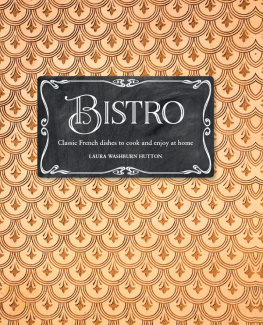

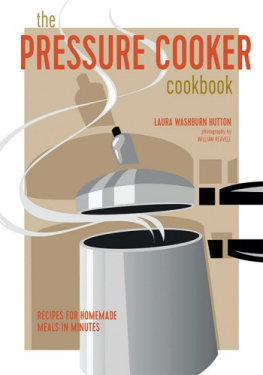
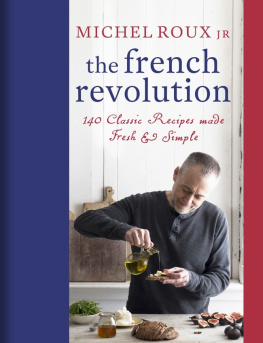

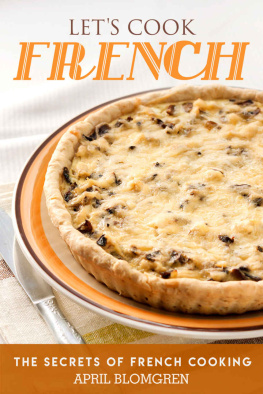
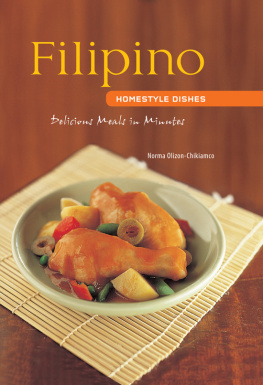
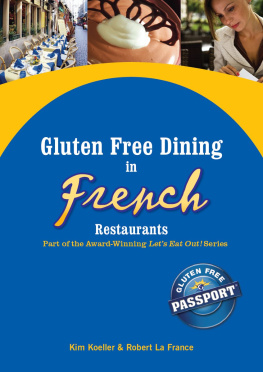
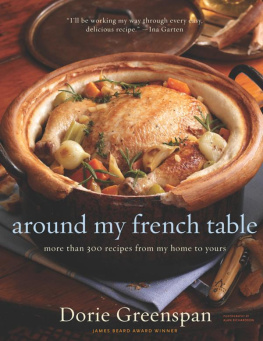

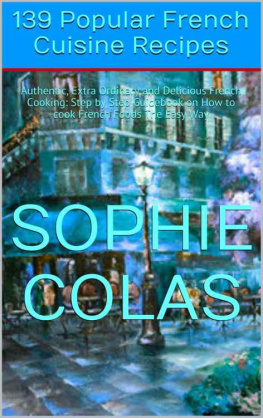
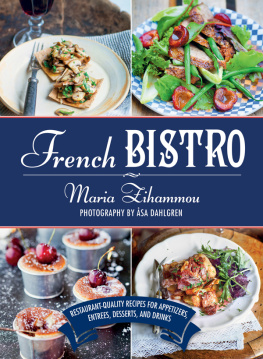


 Bistro Classic French dishes to cook and enjoy at home Laura Washburn Hutton with photography by Martin Brigdale
Bistro Classic French dishes to cook and enjoy at home Laura Washburn Hutton with photography by Martin Brigdale 
 DESIGNER Steve Painter EDITOR Sarah Vaughan EDITORIAL DIRECTOR Julia Charles HEAD OF PRODUCTION Patricia Harrington ART DIRECTOR Leslie Harrington PUBLISHER Cindy Richards FOOD STYLISTS Linda Tubby & Bridget Sargeson PROP STYLIST Helen Trent INDEXER Hilary Bird Originally published in 2010 as The French Country Table by Laura Washburn Hutton. This updated edition published in 2020 by Ryland Peters & Small 2021 Jockeys Fields London WC1R 4BW www.rylandpeters.com 10 9 8 7 6 5 4 3 2 1 Text Laura Washburn Hutton 2010, 2020 Design and photographs Ryland Peters & Small 2010, 2020 Printed in China The authors moral rights have been asserted. All rights reserved. No part of this publication may be reproduced, stored in a retrieval system, or transmitted in any form or by any means, electronic, mechanical, photocopying, or otherwise, without the prior permission of the publisher. ISBN: 978-1-78879-282-0 EISBN: 978-1-78879-317-9 A CIP record for this book is available from the British Library. US Library of Congress CIP Data has been applied for.
DESIGNER Steve Painter EDITOR Sarah Vaughan EDITORIAL DIRECTOR Julia Charles HEAD OF PRODUCTION Patricia Harrington ART DIRECTOR Leslie Harrington PUBLISHER Cindy Richards FOOD STYLISTS Linda Tubby & Bridget Sargeson PROP STYLIST Helen Trent INDEXER Hilary Bird Originally published in 2010 as The French Country Table by Laura Washburn Hutton. This updated edition published in 2020 by Ryland Peters & Small 2021 Jockeys Fields London WC1R 4BW www.rylandpeters.com 10 9 8 7 6 5 4 3 2 1 Text Laura Washburn Hutton 2010, 2020 Design and photographs Ryland Peters & Small 2010, 2020 Printed in China The authors moral rights have been asserted. All rights reserved. No part of this publication may be reproduced, stored in a retrieval system, or transmitted in any form or by any means, electronic, mechanical, photocopying, or otherwise, without the prior permission of the publisher. ISBN: 978-1-78879-282-0 EISBN: 978-1-78879-317-9 A CIP record for this book is available from the British Library. US Library of Congress CIP Data has been applied for.  Contents
Contents  Introduction The cuisine of France is exceptional. It is based on local ingredients and regional recipes, and a great deal of respect for tradition.
Introduction The cuisine of France is exceptional. It is based on local ingredients and regional recipes, and a great deal of respect for tradition. Another vital component is time.
Another vital component is time. Appetizers
Appetizers  Rustic pt with green peppercorns Terrine de campagne au poivre vert If youve never made your own terrine, try this. It is simplicity itself, and you may never use shop-bought pts again.
Rustic pt with green peppercorns Terrine de campagne au poivre vert If youve never made your own terrine, try this. It is simplicity itself, and you may never use shop-bought pts again.